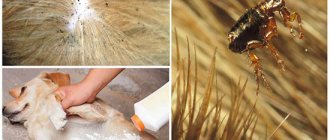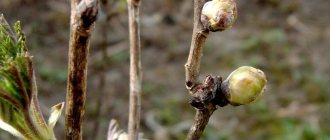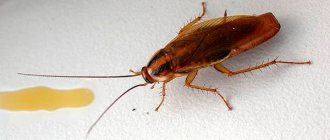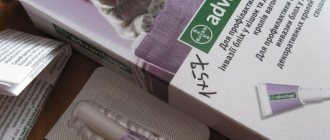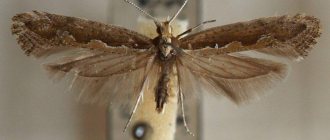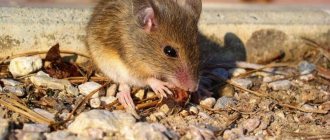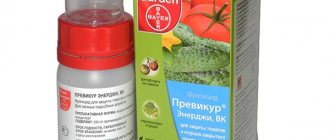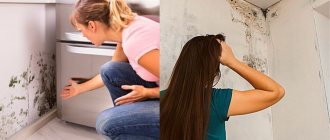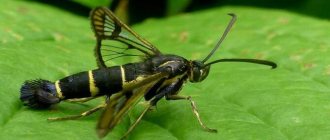Aphids are one of the most common insects. Colonies of this pest can be found on almost all agricultural crops: from cabbage to shrubs and fruit trees.
Dear readers! For you, we have created communities on social networks in which useful articles and interesting ideas are published several times a day! Subscribe and receive useful content in a convenient format!
The fight against aphids is made difficult by the fact that the insect captures all the shoots on the plant. In addition, the presence of this pest in the vast majority of cases indicates the presence of an anthill nearby. That is, you will actually need to fight 2 pests at once.
In this article we will talk about the types of aphids and how to fight this insect with the help of chemicals and folk remedies.
What does the pest look like?
Aphids
Aphids are insects approximately 8 mm long.
INTERESTING. There are species with a body size even less than 1 mm. This aphid usually lives on indoor flowers.
There are many varieties of aphids. Among the most dangerous crops are: pea, green, melon, carrot, legume, greenhouse, gall, etc. The color of the insect depends on the species. It can be black, green, white and even red.
Aphids feed on plant sap. Lives in colonies and moves from one bush to another. First of all, young shoots and leaves suffer from them. If you don’t fight aphids, the currants will wither pretty quickly.
Aphids are often “bred” by black ants, which feed on their secretions. Therefore, while destroying aphid colonies, it is also necessary to fight ants.
Varieties of aphids
In nature, there are more than 4 thousand species of aphids, 8 of which are dangerous for currants and other fruit and berry crops. Each species is recognized not only by its external characteristics, but also by secondary signs of its life activity.
The following are considered harmful for currants:
- red gall aphid;
- bird cherry;
- beet;
- blackberry;
- green;
- currant-salad;
- peach
The red gall type has winged and wingless varieties. The first is distinguished by its larger size and rich green color. Winged representatives have a watery-yellow body and a pair of transparent wings. The pest can be recognized by reddish swellings in the central part of currant leaves. The branches of an infected bush are dotted with galls - red-brown growths in which aphids breed. When damaged, insects patch up the holes with their own bodies and milk, as a result of which they die.
Red gall type of aphids
cherry type is distinguished by its brown color and is the main carrier of vector-borne infections. When it appears, the leaves of the plant dry out and curl into a tube.
Bird cherry type of aphid
The beet (bean) type has an oval shape and a black (less often olive) color. It rarely affects currants, as it specializes in legumes and root crops. Signs of infestation include yellowed punctures on young shoots and curled foliage.
Beet aphid
Blackberry aphid has a yellow-green color. It feeds on the fruiting buds of plants, causing their productivity to suffer. Identified by drying tops and yellowing buds. It attacks not only blackberry bushes, but also settles on currants, raspberries, grapes, and apple trees.
Currant - green aphid , the period of active activity of which falls in June and July, in 4-5 generations gives birth to winged forms that can migrate to neighboring bushes and branches. Belongs to the oviparous species. The breeding season falls in September. Females lay eggs under the currant bark and cover the laying site with milk. Overwintered larvae are capable of reproduction on the 2nd day of life. Signs of the appearance of this type in spring, summer, and autumn are curled leaves and slow growth of the bush.
Currant - green aphid
Currant - lettuce aphid differs from the above in its orange color and the ability to carry Gooseberry virus.
The peach form has a light green color and small dimensions. It is most dangerous for currants, since one puncture can transmit up to 120 types of infection to the bush.
Peach aphid
What is gall aphid and what does it look like?
Gall aphids are one of the most dangerous for plants. Most often it affects red currant bushes.
In an effort to heal wounds from aphid bites, currants form special growths on the leaves, which are called galls. It is by these that one can most often determine the presence of aphids on a bush.
The result of the influence of gall aphids
The fact is that the gall aphid is very small, and it is very difficult to notice it among dense growth. The task is complicated by the fact that the gall aphid is colored pale green and is barely noticeable against the background of the leaves.
The gall aphid poses an additional danger to currants due to the fact that it is a carrier of various infections.
Signs of damage to currants by aphids
The currant bush opens its buds early, and a good shelter with green food supply appears for the overwintered aphids. Pest parasitism can be suspected based on general signs:
- curvature of petioles, cessation of growth and development of currant shoots;
- shortening of internodes;
- winter death of damaged plants, delayed bud break in spring;
- a slowdown in the overall development of the currant bush, a decrease in yield and a deterioration in the quality of berries.
A characteristic manifestation of gooseberry aphids in black currants. On the apical part of the bush, curled shoots and twisted leaf plates are clearly visible. The affected sheets bend downward and inward. The ovary looks like a lump of greenery, inside of which a colony of insect pests lurks.
What does a red or white currant look like when affected by gall aphids? Red bumps, swellings and spots are noticeable in the central part of the leaves. The branches acquire a reddish-brown coating and small growths. Sometimes, due to the bright color of the affected areas, the pest is called the red-headed aphid.
Why are green aphids dangerous?
Green aphids pose a real danger to fruit trees, especially apple and pear trees.
Insects spend the winter hidden in the bark. With the onset of warming, larvae appear and devour the buds, gradually moving to the leaves, inflorescences and fruits.
The main signs of a tree being affected by green aphids are leaf curling, growth stunting and drying out. If aphids are not removed in time, over the course of a season they will produce about 1.5 dozen generations of pests that will spread throughout the garden.
Aphids are most destructive in gardens where there are many trees and it is difficult to keep track of everyone.
Preventive measures
If foci of aphid infestation are found in the garden plot, the gardener must always be on alert. The “faithful” friends of aphids, ants, will try and spread the pest throughout the garden. To reduce labor costs in combating a tiny but voracious pest, preventive work should be carried out to prevent its occurrence.
- It is necessary to constantly fight against garden ants, which carry aphids from plant to plant and hide them in their anthills for the winter.
- Keep the tree trunk area clean. Remove weeds in a timely manner and, if possible, plant pest-repellent plants in close proximity: onions, garlic, parsley, coriander, basil. Among the flowers, tansy, marigold, calendula, nasturtium, and cosmos have such properties. The smell of flowers is not liked by aphids, but attracts beneficial insects that eat the pest: ladybugs and lacewings.
- Remove damaged shoots and branches during the spring and autumn formation of the bush.
- Regularly loosen the soil under the plant and around the entire crown.
- Clear currant trunks of loose bark, which can serve as a shelter for laying eggs of the pest in winter.
How to treat aphids - effective drugs?
Currently, the store sells many aphid medications. First of all, they differ in the principle of their action (contact, contact-intestinal insecticide). The main active ingredient of the drug (imidacloprid, permethrin, malathion, aversectin, thiamethoxam, neonicotinoid, etc.) depends on this.
You need to choose a drug based on its duration, the number of necessary treatments, effectiveness, and danger to the crop itself and bees. For example, when using Fufanon , you need to be aware that it kills all insects indiscriminately. Therefore, when purchasing a product in a store, carefully read the instructions.
Fufanon
The most effective drugs in the fight against aphids: Iskra, Tanrek, Aktara, Biotlin, Senpai, Fitoverm, Trichopol, Aktofit, Alatar, Commander, Jaguar, Strela, Iskra, Karbofos, Zubr, Konfidor, Warrant, Cruiser .
What are the dangers of chemical treatment?
Chemicals are most effective in controlling aphids, but they also carry a certain danger.
First of all, the use of insecticides during the flowering period is dangerous for bees. This is bad not only in itself, but also from the point of view that pollination will not take place. This means there is a chance to be left without a harvest at all.
Each poison has its own expiration date. If less time passes after processing, harmful substances will still remain in the fruit. There is a considerable chance of getting food poisoning.
In addition, if you prepare an overly concentrated solution, you may simply burn the leaves of the plant.
Dried red currant leaves
Chemicals
Specialized chemicals, on the one hand, give the best results, but on the other hand, they tend to accumulate in plant tissues. Therefore, we recommend using insecticides only as a last resort if simpler methods do not help.
By the way, industrial preparations can also be organic - based on pyrethrins, vegetable oils or fatty acids. More drastic measures are often not necessary because the aphid's shell is very soft. Even ordinary soap destroys it quite effectively.
Photo: moscow-oblast.sm-news.ru
How to fight aphids on currants using traditional methods
Aphids can be controlled not only with chemicals. Folk remedies are also quite effective.
How to spray with ammonia and ammonia?
A solution based on ammonia is prepared from 2 tablespoons of alcohol, 10 liters of water and 2 tablespoons of liquid soap (you can use laundry soap).
Carry out the treatment in the morning or evening.
How to remove soda
The solution is prepared from 10 tablespoons of soda and 10 liters of water. To fix the active substance on currant leaves, you can add liquid or laundry soap.
How to use soap solution
A soap solution to protect against aphids is prepared from 1 ground piece of laundry soap and a bucket of water. The composition takes a long time to prepare, since the soap needs to be completely dissolved.
Treated bushes are protected until rain falls to wash away the soap from the leaves. This is the main drawback of the method.
Laundry soap is the most affordable means of combating aphids
How to use vinegar?
The vinegar solution against aphids is diluted in the ratio of 1 spoon of apple cider vinegar per 1 liter of water. Aphids cannot stand the smell of the product and leave the treated currant bushes.
Garlic infusion
Garlic infusion should be used before harvesting. The recipe is as follows: 400 g of finely chopped garlic cloves, pour 10 minutes of water and leave for 4 days. Then the infusion is filtered and the currant bushes are processed.
Garlic kills existing aphids and drives away new pests from plants.
Infusion of potato tops
The working solution is prepared from 0.8 kg of chopped tops and 10 liters of boiling water. Leave for 3 days, then strain and process the currant bushes.
How to use tobacco
Tobacco infusion is fatal to aphids. It is prepared from 20-30 g of dry tobacco and 5 liters of boiling water. Leave until the solution cools completely. To fix tobacco on currant leaves, use laundry soap.
Infusion of tomato tops
For this recipe you will need about 3 kg of tomato shoots, stems and leaves. Finely chop all the greens and pour in 10 liters of hot water. Leave the concentrate for 7 hours. Then strain it and prepare a working solution, mixing it with water in a ratio of 1 to 4.
How to use onion peel infusion
Onion peel infusion.
Onion infusion is prepared very simply: 0.5 kg of onion peel is poured into a bucket of water and infused for 5 days. Before use, filter the solution so that it sprays better.
The disadvantage of this product is that it protects the currants only until the first major rain.
Pepper infusion
The pepper infusion can be used only before the fruits appear, since there is a high probability of retaining a burning taste in the berries.
Recipe: 5 g of dried pepper must be boiled for 10 minutes in 1 liter of boiling water. The concentrate is cooled and mixed with 7 liters of water.
How to get rid of a pest with Coca-Cola
The solution is prepared from 1 liter of cola and 7 liters of water. An additional advantage of treating with this composition is that it attracts bees, which flock to the sweet drink.
Spraying with infusion of celandine
Currants can be treated with celandine only before fruiting begins, as this plant is poisonous.
The celandine must be torn up along with the roots. Before you pour the grass, you need to chop it finely. You need very little water, a little more than celandine level. The infusion is prepared overnight and applied upon morning dew.
How to use vodka?
This is one of the most ineffective remedies. Spray the affected bushes with undiluted vodka. The aphids fall off, but appear again a day later, so it is advisable to treat with this composition only during harvest, in order to then poison the aphids with chemicals.
Does boiling water help in the fight?
Scalding currants with boiling water in early spring
Spraying currants with boiling water can only be done in early spring, before the buds open. Otherwise, the plant itself will die.
How to use mustard
Mustard does not give results immediately. To achieve the greatest effect, plants need to be treated several times a month, but the results last longer.
Recipe: Mix 15 g of mustard with 1 liter of water. Infuse for 2 days in a warm place. Mix the resulting concentrate with 5 liters of water and treat the affected bushes.
Fufanon with fast-acting effect
Fufanon
Organophosphorus emulsion, produced in 10 ml bottles and 5 ml ampoules. The main component of the drug is melation. Has a fast-acting effect. When contacted with aphids, it causes complete paralysis after 2 hours of action and death after 24 hours.
Before treating currants with this product, it is necessary to wait at least 15 days from the date of the last feeding. It is completely incompatible with other chemicals. To prepare an aqueous solution, use 5 ml of the substance and 5 liters of clean water.
Spray currants on a cloudy day in the early morning or at sunset. The duration of action does not exceed 4-7 days; after the specified time period, the bushes must be sprayed again.
What to use in the fight if the plant already has berries?
When aphids appear on currant bushes with berries, treatment should be carried out exclusively using folk remedies. Since the period from chemical treatment to harvest must be at least 30 days.
Red currant fruits on an infected bush
The most effective remedy is ammonia. But you also need to be careful with him. The ammonia will take several days to dissipate. This must be taken into account when processing plants.
The safest products are a solution based on laundry soap, an infusion of garlic and an infusion of onion peels.
ADVICE. If aphids have just appeared on currants, then quickly harvest the crop and then use chemicals.
Other ways to fight
Experienced gardeners use simple but effective methods to combat aphids on currants:
- Processing with boiling water . It is carried out in early spring before the buds open. Boiling water is poured into a watering can with small holes and the bushes are irrigated from a distance of 70-100 cm. Hot water destroys clutches of aphid eggs that overwinter in leaf axils and cracks in the bark. Streams of water reaching the branches of the bush cool down to a temperature of 60-65˚C and do not harm the currants, but have a detrimental effect on parasites.
- Watering with a hose . A strong stream of water is directed at the currant bushes and knocks the aphids to the ground. It is difficult for wet pests to climb onto the plant; predator insects lie in wait for them on the ground - ground beetles, grasshoppers, and hoverfly larvae. The event is carried out repeatedly, in the morning or evening, so that the leaves of the plant do not get sunburn.
- Removing damaged foliage . Shoots affected by aphids are torn off, burned or taken outside the site. The procedure does not cause much harm to the bush, but significantly reduces the number of parasitic insects. Healthy shoots appear from the leaf axils, which will produce a full harvest next year.
- Fumigation . Near the bushes they burn objects made of rubber or caoutchouc, which burn slowly but smolder for a long time. The event is held in calm weather. Acrid smoke destroys aphids at all stages of development and protects against the appearance of new pest colonies.
- Planting repellent plants . Aphids are extremely sensitive to strong odors. Currant bushes located near the beds of onions, garlic, potatoes and tomatoes are avoided by the pest. The insect cannot stand the smell of marigolds, sage, chamomile-pyrethrum and calendula. An apothecary bed, built near a currant plantation, will bring tangible benefits. Scented herbs: wormwood, lavender, mint, valerian and thyme effectively repel aphids.
Alternative control methods are environmentally friendly and allow you to successfully combat the pest without the use of pesticides.
How to repel aphids using plants planted nearby
You can also combat the appearance of aphids with preventive measures. For example, by planting repellent plants next to currants. Such plantings will repel most pests, and you will not have to remove aphids at all later.
The pest does not tolerate plants such as coriander, nasturtium, mustard, and marigolds. If you plant them around the perimeter of currant bushes, they will become a good barrier to aphids.
Plants that attract natural enemies of aphids, such as ladybugs, can also help. These are mint, dill, basil, thyme.
REFERENCE. Repellent plants will not get rid of the pest completely, but they can significantly reduce its number.
Reasons why it starts
Aphids parasitize not only cultivated crops, but also wild plants. However, tender currant shoots are an easily accessible delicacy for her. In addition, the currant bush opens its buds very early and becomes both a refuge and an excellent food supply for insects.
An additional factor is black ants, which massively disperse aphids into new bushes. Ants feed on the “milk” secreted by aphids, so these insects are cultivated.
Why are aphids dangerous for currants?
An aphid invasion of plantings can destroy all bushes in a short period of time. Aphids are extremely aggressive and incredibly prolific: 10-15 generations of pests are replaced over the summer. They all attack young shoots, leaves and berries, sucking the juices out of them. A bush, deprived of nutrition, soon weakens and dies. Tender new shoots are especially affected. Additionally, plantings may suffer from viral and fungal diseases carried by aphids.
Prevention
Treating currants against aphids
Fighting aphids is a rather dreary and labor-intensive task. It is much easier to prevent pests from appearing than to try to get rid of them later.
Preventative measures include:
- Regular inspection of bushes;
- Preventive treatment with a weak solution of ammonia;
- Mulching. Earwigs, natural enemies of aphids, live in sawdust;
- Fighting black ants;
- Tying the shoots with double-sided tape so that pests cannot climb to the leaves;
- Planting repellent plants;
- Attracting birds. Here you need to be very careful, otherwise you will have to fight the dominance of birds later.
Biological products
These drugs are prepared using components such as bacteria, fungi and other substances of biological origin. They are absolutely safe and their only drawback is that they act too slowly.
Fitoverm
To destroy aphids on currant bushes, you need to dilute the drug with water in a ratio of 2: 1000. Fitoverm can be used once every 20 days. Individuals of garden aphids begin to die after approximately 72 hours.
Entobacterin
This biological product is toxic to many types of harmful insects. To effectively combat aphids, it should be diluted with water at the rate of 10 grams of powder per 1 liter of water. It is better to treat currants against aphids at an air temperature of + 250C and above. In this case, the maximum effect is expected. The bushes must be treated at least twice with an interval of 7 days.
Arrow
"Strela" has a delayed duration of action, and the result appears after 10-15 days. A standard package of 50 grams is diluted in 10 liters of water. With a large number of aphids, the concentration can be increased.
You can pick berries two days after treating the bushes with Strela.
30-plus
The drug is available in containers of 250 and 500 ml. The insecticide is diluted in 5 and 10 liters of water, respectively. The solution remains active for only two hours, so it must be diluted immediately before use.
Tanrek
"Tanrek" is active for many types of insects, including bees, so it cannot be used during flowering. The drug is absorbed into the leaves and affects aphids as they feed on plant sap. The drug should not be used in sunny weather, as it can burn the leaves.
Confidor
The drug remains active in any weather and allows you to cope with the massive spread of aphids.
"Confidor" is available in the form of an emulsion and a water-soluble concentrate.
There are more active versions of the drug - these are “Confidor Maxi” and “Confidor Extra”
Biotlin
This drug works well not only against aphids, but also against garden ants, which are distributors of these pests. The concentrated solution in ampoules is very economical. By dissolving one 3 ml ampoule in 10 liters of water, you can treat 7-8 currant bushes. This link will tell you how to fight aphids on pear trees.
Common mistakes
Processing only the upper part of the sheet plates.
To completely remove aphids, you need to carefully process the currant leaves. Aphids most often hide on the lower part of the leaf blade. Therefore, surface treatment of shrubs will be less effective.
Spraying with chemicals during the flowering period.
Most insecticides are harmful to all insects, both beneficial and pests. Therefore, when currants bloom, they need to be treated with folk remedies.
Processing of shrubs too late.
Currant leaf withered due to gall aphids
You need to start fighting aphids as early as possible. By processing the currants too late, you will, of course, get rid of parasites, but the bush may already die.
Incorrectly selected concentration of the active substance.
When preparing the working solution, you must strictly follow the instructions. A weaker solution will not be as effective, and a stronger one may burn the leaves of the bush.
Fumigating branches with burnt rubber helps kill aphids
Keep in mind that folk remedies cannot be compared with chemical pesticides, so they are applied regularly and often.
They not only save the bush from aphid invasion, but also feed:
§ nitrogen, when adding ammonia solution to the roots (50 ml: 10 l of water). Laundry soap (100 g) is used as an adhesive. Repeated treatment is carried out after 2 weeks.
§ when spraying shoots with soda solution (10 tbsp: 10 l of water: 100 g of soap), the plant is enriched with calcium.
§ in May, wood ash is sprinkled on the currant roots or sprayed with an ash solution (200 g: 10 l of water).
§ Tobacco replenishes the deficiency of nitrogen and phosphorus, and also repels pests. First, the bushes are treated with a soap solution and sprinkled with tobacco dust.
Answers to popular questions
Strange brownish-red bumps appeared on the currant leaves. What is this?
This is a consequence of the influence of gall aphids on the bush. It is urgent to treat the affected plant. Also, for prevention, spray neighboring bushes and crops.
Aphids covered the entire bush. What to do?
It is necessary to carry out complex treatment using chemical insecticides (for example, using Aktara). The work must be done very carefully, spraying every leaf and every twig. Additionally, you can fumigate the bush with tobacco smoke.
How to fight aphids if the currants have already ripened berries?
Use folk remedies: soap solution, infusion of garlic or onion peel. If there are still a few days left before picking the berries, then the currants can be treated with ammonia solution. This is the most effective remedy.
What means are best to use? Drugs from the store or folk recipes?
There is no clear answer to this question. Chemicals are more effective, but they cannot be used during flowering and fruiting. The optimal solution is to use both store-bought drugs and folk remedies.
